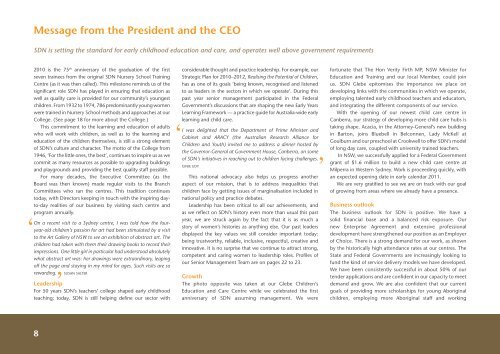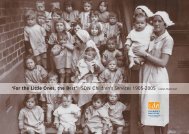SDN Children's Services Inc. Annual Report 2010
SDN Children's Services Inc. Annual Report 2010
SDN Children's Services Inc. Annual Report 2010
You also want an ePaper? Increase the reach of your titles
YUMPU automatically turns print PDFs into web optimized ePapers that Google loves.
Message from the President and the CEO<br />
<strong>SDN</strong> is setting the standard for early childhood education and care, and operates well above government requirements<br />
‘<br />
<strong>2010</strong> is the 75 th anniversary of the graduation of the first<br />
seven trainees from the original <strong>SDN</strong> Nursery School Training<br />
Centre (as it was then called). This milestone reminds us of the<br />
significant role <strong>SDN</strong> has played in ensuring that education as<br />
well as quality care is provided for our community’s youngest<br />
children. From 1932 to 1974, 786 predominantly young women<br />
were trained in Nursery School methods and approaches at our<br />
College. (See page 18 for more about the College.)<br />
This commitment to the learning and education of adults<br />
who will work with children, as well as to the learning and<br />
education of the children themselves, is still a strong element<br />
of <strong>SDN</strong>’s culture and character. The motto of the College from<br />
1946, ‘For the little ones, the best’, continues to inspire us as we<br />
commit as many resources as possible to upgrading buildings<br />
and playgrounds and providing the best quality staff possible.<br />
For many decades, the Executive Committee (as the<br />
Board was then known) made regular visits to the Branch<br />
Committees who ran the centres. This tradition continues<br />
today, with Directors keeping in touch with the inspiring dayto-day<br />
realities of our business by visiting each centre and<br />
program annually.<br />
On a recent visit to a Sydney centre, I was told how the fouryear-old<br />
children’s passion for art had been stimulated by a visit<br />
to the Art Gallery of NSW to see an exhibition of abstract art. The<br />
children had taken with them their drawing books to record their<br />
impressions. One little girl in particular had understood absolutely<br />
what abstract art was: her drawings were extraordinary, leaping<br />
off the page and staying in my mind for ages. Such visits are so<br />
rewarding. Susan Salter<br />
‘<br />
Leadership<br />
For 50 years <strong>SDN</strong>’s teachers’ college shaped early childhood<br />
teaching; today, <strong>SDN</strong> is still helping define our sector with<br />
‘<br />
considerable thought and practice leadership. For example, our<br />
Strategic Plan for <strong>2010</strong>–2012, Realising the Potential of Children,<br />
has as one of its goals ‘being known, recognised and listened<br />
to as leaders in the sectors in which we operate’. During this<br />
past year senior management participated in the Federal<br />
Government’s discussions that are shaping the new Early Years<br />
Learning Framework — a practice guide for Australia-wide early<br />
learning and child care.<br />
I was delighted that the Department of Prime Minister and<br />
Cabinet and ARACY (the Australian Research Alliance for<br />
Children and Youth) invited me to address a dinner hosted by<br />
the Governor-General at Government House, Canberra, on some<br />
of <strong>SDN</strong>’s initiatives in reaching out to children facing challenges.<br />
Ginie Udy<br />
This national advocacy also helps us progress another<br />
aspect of our mission, that is to address inequalities that<br />
children face by getting issues of marginalisation included in<br />
national policy and practice debates.<br />
Leadership has been critical to all our achievements, and<br />
as we reflect on <strong>SDN</strong>’s history even more than usual this past<br />
year, we are struck again by the fact that it is as much a<br />
story of women’s histories as anything else. Our past leaders<br />
displayed the key values we still consider important today:<br />
being trustworthy, reliable, inclusive, respectful, creative and<br />
innovative. It is no surprise that we continue to attract strong,<br />
competent and caring women to leadership roles. Profiles of<br />
our Senior Management Team are on pages 22 to 23.<br />
Growth<br />
The photo opposite was taken at our Glebe Children’s<br />
Education and Care Centre while we celebrated the first<br />
anniversary of <strong>SDN</strong> assuming management. We were<br />
‘<br />
fortunate that The Hon Verity Firth MP, NSW Minister for<br />
Education and Training and our local Member, could join<br />
us. <strong>SDN</strong> Glebe epitomises the importance we place on<br />
developing links with the communities in which we operate,<br />
employing talented early childhood teachers and educators,<br />
and integrating the different components of our service.<br />
With the opening of our newest child care centre in<br />
Canberra, our strategy of developing more child care hubs is<br />
taking shape. Acacia, in the Attorney-General’s new building<br />
in Barton, joins Bluebell in Belconnen, Lady McKell at<br />
Goulburn and our preschool at Crookwell to offer <strong>SDN</strong>’s model<br />
of long day care, coupled with university trained teachers.<br />
In NSW, we successfully applied for a Federal Government<br />
grant of $1.6 million to build a new child care centre at<br />
Milperra in Western Sydney. Work is proceeding quickly, with<br />
an expected opening date in early calendar 2011.<br />
We are very gratified to see we are on track with our goal<br />
of growing from areas where we already have a presence.<br />
Business outlook<br />
The business outlook for <strong>SDN</strong> is positive. We have a<br />
solid financial base and a balanced risk exposure. Our<br />
new Enterprise Agreement and extensive professional<br />
development have strengthened our position as an Employer<br />
of Choice. There is a strong demand for our work, as shown<br />
by the historically high attendance rates at our centres. The<br />
State and Federal Governments are increasingly looking to<br />
fund the kind of service delivery models we have developed.<br />
We have been consistently successful in about 50% of our<br />
tender applications and are confident in our capacity to meet<br />
demand and grow. We are also confident that our current<br />
goals of providing more scholarships for young Aboriginal<br />
children, employing more Aboriginal staff and working<br />
8 <strong>SDN</strong> <strong>Annual</strong> <strong>Report</strong> <strong>2010</strong>





